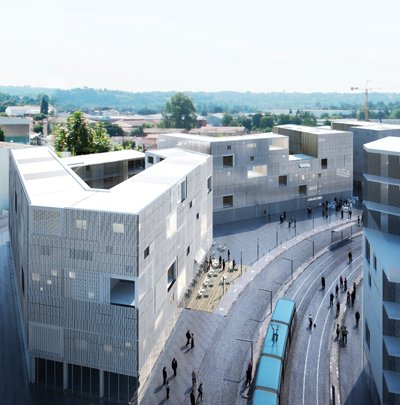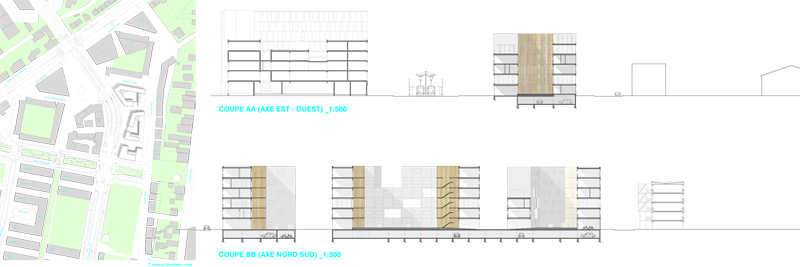Festival dell'architettura
Ti trovi in: Home page > Progettare il costruito strategie architettoniche per la città compatta > FRANCIA - Bègles, 72 collective housing units (2009/2012), LAN Architecture
FRANCIA - Bègles, 72 collective housing units (2009/2012), LAN Architecture

CLIENT: Ataraxia, Saemcib
LOCATION: Quartier Terres Neuves, Bègles (33)
COST: 6.5 M € HT
BUILT UP AREA: 6,500 m2
COMPETITION: 2009
COMPLETION: 2012
TEAM: LAN Architecture (lead architect), Agence Franck Boutté (HEQ consultant), Batiserf Ingénierie (structure), Michel Forgue (quantity surveyor), LBE (fluids)
A new, ecological and social living space geared to the 21st century.
The project’s richness and major interest lie in the possibility of inventing an urban lifestyle set in a highly experimental framework enabling the affirmation of new ecological and contemporary architectures.
The diversity of architectural propositions and communal and private spaces had to ensure and enhance this specificity.
The first stage was to ‘sculpt’ the volumes in order to exploit their urban potential and intrinsic spatial qualities. We directed our research towards a hybrid typology combining the house and the apartment.
The principle underlying our approach was that of stacking containers, and careful study of habitat modes, climatic conditions and the sun’s trajectory throughout the year suggested the way to organise this.
The construction system is extremely simple: a concrete column-slab structure with a regular framework, into which we integrated prefabricated wood-frame panels. The panels’ weather-proofing, insulation and sun screen components were all pre-assembled. All the façade’s components could therefore be installed on site in a single operation.
The relative narrowness of the buildings dictated a strategic search for compactness. The idea of variable compactness introduced the notion of a housing unit’s adaptability to seasons and times of day.
The morphology of each unit stems from the wish to develop housing units enabling a variety of uses very simply and with no extra technological input. We are therefore proposing cross-building units with adaptable exterior spaces and at least two different orientations.
Our typology of plan is based on the échoppe, the traditional worker’s house in the Bordeaux region. Its principle is simple: rooms on either side of a central corridor leading to a back garden. Then, we developed a direct link between this model and the project in our work on the plan. The 2 to 5-bedroom units are all organised around a corridor separating the day and night zones and leading to an exterior loggia.
We were very radical inside: no false ceilings, standard sanitary equipment and PVC or rubber floors.
Each unit had so many intrinsic qualities: triple orientation, optimum sun exposure and also very ample volumes.
We proposed something between a “Mediterranean way of life” and a German Passive House. As in Germany, our apartments can be completely closed in winter, as hermetically as possible. As in Mediterranean areas, the apartments can also be open in the summertime, allowing inhabitants to live in a ventilated, outside space.
The building is white during the day, then redefines itself by night, through the perforations revealing the life inside.









